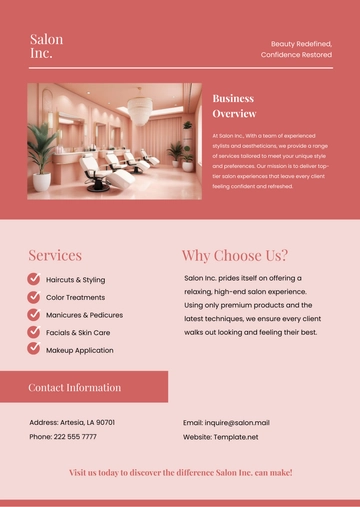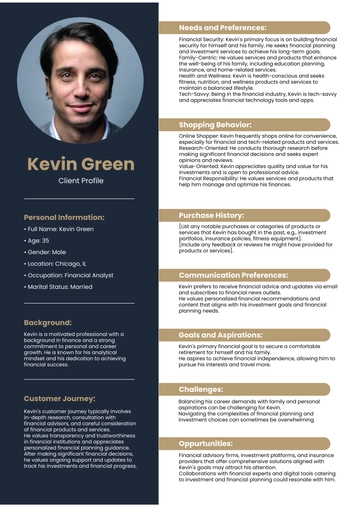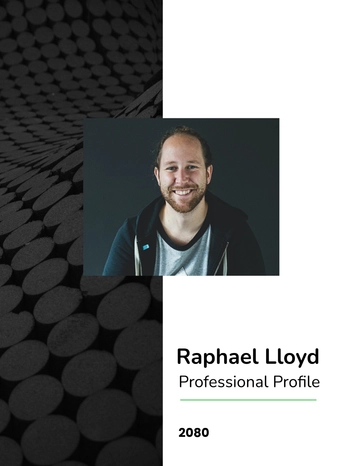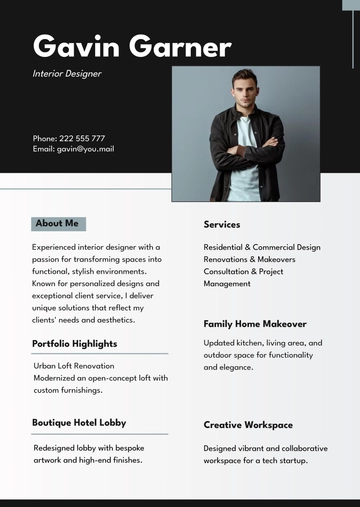Free Interior Design Designer Profile

I. Introduction
As we advance into the future, the field of interior design continues to evolve, incorporating technology, sustainability, and human-centered innovation. [Your Company Name] stands at the forefront of this transformation, offering unparalleled interior design services that blend artistic flair with cutting-edge solutions. This profile delves into the professional capabilities, portfolio, values, and expertise of our interior designers, providing a detailed insight into the creative force driving our projects.
II. About [Your Company Name]
A. Company Overview
Founded in [year], [Your Company Name] has built a legacy of excellence in the world of interior design. As of the year 2050, we are recognized as a leading interior design firm, renowned for innovative, eco-friendly, and technologically advanced design solutions. Our approach fuses aesthetic brilliance with the latest design technologies, creating environments that are not only visually stunning but also highly functional.
1. Mission Statement
Our mission is to transform spaces into experiences, fostering environments that inspire, engage, and resonate with the people who live and work in them. We are committed to:
Designing spaces that reflect the unique character of our clients: We believe that every space should be a true reflection of its occupants. Our designs are tailored to the individual preferences and lifestyles of our clients, ensuring that each project is a unique expression of their vision.
Emphasizing sustainability and environmental consciousness: In an era where environmental issues are increasingly pressing, we prioritize sustainable design practices. This includes selecting eco-friendly materials, implementing energy-efficient solutions, and reducing waste throughout the design process.
Integrating the latest design technologies to improve functionality and comfort: Our designs are enhanced by the latest technological advancements, such as smart home systems, AI-driven solutions, and cutting-edge materials. This integration ensures that our spaces are not only beautiful but also highly functional and comfortable.
Offering a collaborative and client-focused approach to every project: Collaboration is at the heart of our process. We work closely with our clients from the initial consultation through to project completion, ensuring that their needs and preferences are central to every decision we make.
2. Vision
By 2050, we envision [Your Company Name] as the global leader in interior design, creating spaces that are smart, sustainable, and aesthetically superior. Our designs will shape the way people experience their homes, workplaces, and public spaces for generations to come. We aim to set new standards in the industry, pushing the boundaries of what is possible and continually redefining the concept of interior design.
B. Core Values
Our core values guide every project we undertake:
Creativity: We believe in pushing the boundaries of design to deliver original and imaginative solutions. Our team of designers is constantly exploring new ideas and experimenting with innovative concepts to create truly unique spaces.
Sustainability: With climate change at the forefront of global concerns, we prioritize eco-friendly materials and sustainable design practices. We are dedicated to reducing the environmental impact of our projects and promoting a more sustainable future.
Innovation: We incorporate state-of-the-art technologies, including 3D printing, virtual reality (VR), and artificial intelligence (AI), to design future-ready spaces. Our commitment to innovation ensures that our designs are at the cutting edge of technology and functionality.
Collaboration: Our designers work closely with clients to ensure that the final design is a true reflection of their vision and needs. We believe that collaboration is key to achieving the best possible outcomes and creating spaces that truly resonate with our clients.
III. Professional Expertise
A. Education and Credentials
Our interior designers at [Your Company Name] are highly trained professionals with diverse educational backgrounds. Each designer is certified and accredited by leading global design associations such as the International Interior Design Association (IIDA) and the American Society of Interior Designers (ASID).
1. Education Background
Bachelor of Fine Arts in Interior Design: Our designers hold degrees from prestigious institutions, where they have mastered the art of space planning, color theory, furniture design, and materials science. This foundational education provides them with a deep understanding of design principles and techniques.
Masters in Sustainable Design: Many of our team members have pursued advanced degrees focused on sustainability, equipping them with the skills to create eco-friendly environments. This specialized knowledge allows us to integrate sustainable practices into every aspect of our design process.
Advanced Certifications: Our designers continually upgrade their skills with certifications in smart home design, AI-integrated spaces, and virtual reality rendering. These certifications ensure that our team remains at the forefront of technological advancements in interior design.
2. Continued Professional Development
The field of interior design is ever-changing, and our designers stay current with the latest trends and technologies by attending annual workshops, seminars, and international design fairs. Through continued learning, our team remains at the cutting edge of the industry, implementing futuristic solutions for modern spaces. We also encourage our designers to pursue additional training in emerging technologies and design methodologies to maintain their expertise and adaptability.
B. Specialized Skills
Our designers bring a vast array of specialized skills to every project, making [Your Company Name] the ultimate partner in creating dynamic, functional spaces. Key areas of expertise include:
Space Planning and Architecture: Our team excels at optimizing layouts to ensure the most effective use of space. Whether it’s residential homes or commercial complexes, we plan every detail to perfection. Our expertise in space planning allows us to create environments that are both aesthetically pleasing and highly functional.
Smart Home Integration: With technology becoming a key aspect of interior design, we specialize in integrating AI and IoT (Internet of Things) to create smart homes and offices. This includes automated lighting, climate control, and voice-activated systems. Our smart home solutions enhance convenience and efficiency, making everyday life easier and more enjoyable.
Sustainable Design: We use environmentally friendly materials such as recycled wood, sustainable textiles, and low-VOC paints to create eco-conscious interiors. Our commitment to sustainability extends to every aspect of our design process, from material selection to energy-efficient solutions.
Virtual Reality Design (VR): We offer clients immersive VR walkthroughs of their spaces before construction begins, allowing them to experience their future environment in real time and make necessary adjustments. This technology provides a realistic preview of the finished design, helping clients visualize and refine their ideas.
Biophilic Design: Our designers incorporate natural elements like indoor gardens, green walls, and sustainable materials to promote health and well-being within living spaces. Biophilic design principles enhance the connection between people and nature, creating environments that are calming and restorative.
C. Technology Integration
In the year 2050, interior design is highly influenced by technological advancements. [Your Company Name] prides itself on adopting the latest technologies to enhance the functionality and aesthetic of our projects. Key technologies we utilize include:
1. Artificial Intelligence (AI)
AI tools help us predict design trends, optimize material usage, and develop layouts that maximize space efficiency. This technology also allows us to automate mundane tasks, giving our designers more time to focus on creative aspects. AI-driven analytics and predictive modeling enable us to make data-informed decisions, ensuring that our designs are both innovative and practical.
2. 3D Printing
Our use of 3D printing technology allows us to create custom furniture, fixtures, and décor elements with unprecedented precision. This method reduces waste and promotes sustainable practices, as only the necessary materials are used. 3D printing also allows for rapid prototyping, enabling us to experiment with new design ideas and quickly bring them to life.
3. Virtual Reality (VR)
Our VR technology provides clients with a virtual representation of their space before the construction phase. This gives clients the ability to interact with their design in a fully immersive environment, making changes and adjustments on the fly. VR also facilitates better communication between designers and clients, ensuring that all parties have a clear understanding of the design vision.
4. Smart Materials
In 2050, we incorporate cutting-edge smart materials into our projects. These materials can change color, texture, or transparency based on environmental conditions. Examples include dynamic glass windows that adjust their opacity to control light and temperature, and responsive surfaces that alter their texture to enhance comfort and functionality.
IV. Portfolio and Project Highlights
Over the years, [Your Company Name] has had the privilege of working on numerous high-profile projects, from luxury residential homes to cutting-edge corporate offices. Below are some key examples of our work.
A. Residential Design
We have designed homes that reflect the lifestyle and preferences of our clients, incorporating the latest trends in luxury, sustainability, and smart home technology.
1. Luxury Smart Home – Los Angeles, CA
This [10,000] sq. ft. property features state-of-the-art smart technology integrated into every aspect of the home. From voice-controlled lighting and climate systems to a fully automated kitchen, this home represents the future of residential living. The design incorporates biophilic elements, such as expansive indoor gardens and floor-to-ceiling windows that offer breathtaking views of the surrounding landscape. The use of advanced materials and technology ensures that the home is not only visually stunning but also highly functional and energy-efficient.
2. Eco-friendly Apartment – New York, NY
In this [2,500] sq. ft. eco-conscious apartment, our designers implemented sustainable materials such as bamboo flooring, recycled metal fixtures, and non-toxic paint. The use of natural light and energy-efficient appliances resulted in a space that is both beautiful and environmentally responsible. The apartment also features smart home technology, including automated lighting and climate control, to enhance comfort and efficiency.
B. Commercial Design
From offices to retail spaces, our commercial design projects are rooted in functionality, branding, and user experience.
1. Corporate Headquarters – Silicon Valley, CA
We transformed a [50,000] sq. ft. tech company headquarters into a futuristic workspace, complete with smart desks, automated meeting rooms, and collaborative workspaces. The design incorporates ergonomic furniture, soundproofed areas, and greenery to improve employee wellness and productivity. Advanced technology, such as AI-driven climate control and interactive displays, enhances the functionality and appeal of the workspace.
2. Sustainable Retail Store – Tokyo, Japan
In a [5,000] sq. ft. retail space, we used eco-friendly materials and a minimalist aesthetic to create an inviting and sustainable shopping environment. The store features dynamic digital displays and a layout optimized for customer flow, enhancing the overall shopping experience. The use of smart materials and energy-efficient lighting contributes to the store's sustainability goals.
C. Hospitality Design
We have worked with hotels, restaurants, and leisure spaces to create environments that blend luxury with practicality.
1. Futuristic Hotel – Dubai, UAE
This [100,000] sq. ft. luxury hotel features advanced AI integration, allowing guests to customize their room environments via voice or mobile app. The hotel’s lobby incorporates stunning art installations created using 3D printing technology, while the rooms are equipped with smart materials that adapt to guest preferences for temperature and lighting. The design emphasizes luxury and comfort, with features such as interactive entertainment systems and personalized room settings.
V. Design Process
At [Your Company Name], we follow a meticulously structured design process to ensure that every project is completed to the highest standard.
A. Initial Consultation
We begin by understanding the client’s needs, vision, and budget. During this phase, our designers gather as much information as possible, conducting on-site visits and interviews to get a clear understanding of the space and its requirements. We also discuss the client’s preferences and goals, ensuring that our design approach aligns with their vision.
B. Concept Development
Once the initial consultation is complete, our designers develop several conceptual designs, presenting the client with different options to choose from. This phase involves sketching, 3D modeling, and material selection. We create detailed renderings and mood boards to help clients visualize the proposed design and make informed decisions.
C. Design Refinement
Based on client feedback, the selected concept is further refined, with detailed plans created for construction and installation. At this stage, our designers work closely with contractors, suppliers, and engineers to ensure that the design vision is realized. We address any issues or concerns that arise and make adjustments as needed to ensure the final design meets the client's expectations.
D. Final Execution and Project Management
Once the design is finalized, we manage the entire execution process, ensuring that every aspect of the design is faithfully brought to life. Our project managers oversee timelines, budgets, and quality control, ensuring a seamless transition from concept to completion. We coordinate with all stakeholders, including contractors, suppliers, and subcontractors, to ensure that the project is completed on time and within budget.
VI. Sustainability Commitment
In 2050, sustainability is no longer optional—it is a necessity. [Your Company Name] is fully committed to sustainable design practices, incorporating environmentally responsible materials and energy-efficient technologies into every project.
A. Eco-friendly Materials
Our designers prioritize the use of recycled, renewable, and non-toxic materials. Whether it’s reclaimed wood, bamboo, or organic fabrics, we ensure that our materials have minimal environmental impact. We also seek out suppliers who share our commitment to sustainability, ensuring that every aspect of our projects aligns with our environmental goals.
B. Energy Efficiency
We design spaces with energy efficiency in mind, incorporating solar panels, energy-efficient appliances, and smart climate control systems that reduce energy consumption. Our designs also include features such as passive solar heating, natural ventilation, and low-energy lighting to further enhance energy efficiency.
C. Waste Reduction
From the initial design phase to construction, we implement strategies to reduce waste, ensuring that our projects have as little impact on the environment as possible. This includes utilizing 3D printing technology to minimize excess materials and implementing recycling programs for construction waste. We also work closely with contractors and suppliers to ensure that waste is minimized throughout the construction process.
VII. Awards and Recognitions
Over the decades, [Your Company Name] has been recognized for its excellence in design innovation and sustainability. Some of our notable awards include:
2051 International Green Design Award: For our outstanding contribution to sustainable interior design. This award recognizes our commitment to eco-friendly materials, energy-efficient solutions, and innovative design practices.
2053 Global Interior Design Innovation Award: Acknowledging our groundbreaking use of smart materials and AI integration in interior spaces. This award highlights our ability to incorporate advanced technologies into our designs, enhancing functionality and user experience.
2055 Sustainable Commercial Space Award: Recognizing our efforts in designing eco-friendly commercial environments. This award celebrates our success in creating sustainable and efficient spaces for businesses and organizations.
- 100% Customizable, free editor
- Access 1 Million+ Templates, photo’s & graphics
- Download or share as a template
- Click and replace photos, graphics, text, backgrounds
- Resize, crop, AI write & more
- Access advanced editor
Showcase your talents with the Interior Design Designer Profile Template from Template.net. This editable and customizable template highlights your design expertise and portfolio. Tailor it in our Ai Editor Tool to impress potential clients and partners. Make a lasting impression—design your professional profile today!





























